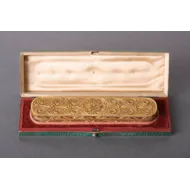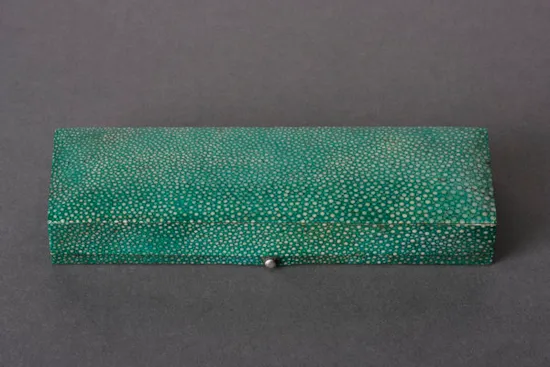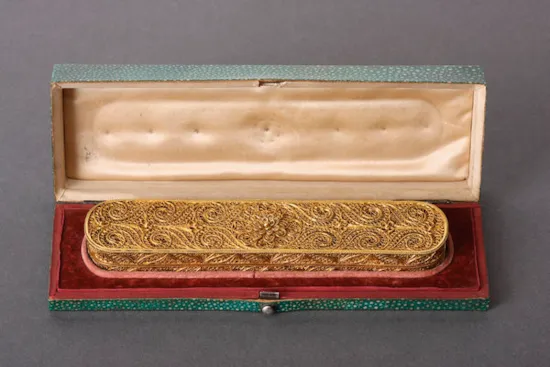A Very Fine George III English Silver Gilt Filigree Toothpick Box
A Very Fine George III English Silver Gilt Filigree Toothpick Box
Contained in its original velvet and silk lined shagreen box
Impeccable condition
Circa 1780 – 1790
Size: 2cm high, 15cm wide, 3cm deep – ¾ ins high, 6 ins wide, 1¼ ins deep
3cm high, 18cm wide, 6cm deep – 1¼ ins high, 7 ins wide, 2¼ ins deep (case)
Contained in its original velvet and silk lined shagreen box
Impeccable condition
Circa 1780 – 1790
Size: 2cm high, 15cm wide, 3cm deep – ¾ ins high, 6 ins wide, 1¼ ins deep
3cm high, 18cm wide, 6cm deep – 1¼ ins high, 7 ins wide, 2¼ ins deep (case)
The origins of filigree work can be traced back to ancient Egyptian gold jewellery and later it was popular as a medium for church plate and other vessels of Renaissance Spanish and German origin. The word ‘filigree’ appears for the first time in English and French dictionaries around 1650, and in 17th century Sweden there existed an entire group of filigree workshops whose products were sent as gifts to the Tsars of Russia.
18th and 19th century English specimens are very seldom marked due to the lack of space upon which to strike a mark without damaging the delicate wirework. Also an act of 1758 that required silversmiths to obtain a license for the manufacture of articles over 5 pennyweights exempted filigree work from being hallmarked providing it did not exceed the prescribed weight which it rarely did. Both Birmingham and London had filigree workers: John Smith of 14 Newhall St. is mentioned in the 1774 issue of Swinney’s Birmingham directory. Somewhat larger (one inch) than is normal for a toothpick box this fine container may have held a dental scraper for scaling the teeth, or possibly a delicate toothbrush, which could dry out in air-conditioned splendour.
18th and 19th century English specimens are very seldom marked due to the lack of space upon which to strike a mark without damaging the delicate wirework. Also an act of 1758 that required silversmiths to obtain a license for the manufacture of articles over 5 pennyweights exempted filigree work from being hallmarked providing it did not exceed the prescribed weight which it rarely did. Both Birmingham and London had filigree workers: John Smith of 14 Newhall St. is mentioned in the 1774 issue of Swinney’s Birmingham directory. Somewhat larger (one inch) than is normal for a toothpick box this fine container may have held a dental scraper for scaling the teeth, or possibly a delicate toothbrush, which could dry out in air-conditioned splendour.
A Very Fine George III English Silver Gilt Filigree Toothpick Box

SOLD






YOU MAY ALSO LIKE


